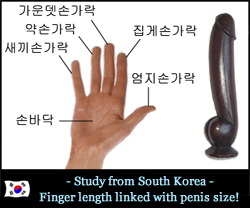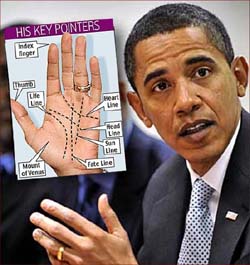The video ‘Evolution of the human hand’ – presents a detailed picture of how modern science perceives the evolution of the human hand in time. The video is sort of based on Darwin’s evolution theory, but the details were delevered by experts in anthropology who studied how the hand shape, finger length & palmar creases evolved during the past 1.8 million years.
The video demonstrates how the ‘early’ humanoid hands (and primates) are typically featured with 3 or more ‘complete transverse creases’ (multiple simian lines), which are positioned horizontal in the hand + two major vertical lines. While at the end of the video displays a typical human hand featured with only 2 curved, oblique positioned ‘primary palmar creases’ (heart line and head line) + one major vertical line (life line).
And the differences between the human hand and the hands of primates served as a model for the evolution of the human hand in time – see below the hands of a man compared to the hands of a baboon, orangutang & chimpanzee.
 Many other fascinating details about the evolution of the human hand are described in the work of physician John Napier, titled: ‘Hands‘.
Many other fascinating details about the evolution of the human hand are described in the work of physician John Napier, titled: ‘Hands‘.
Another important figure in the history of medical science was the Scottish surgeon John Hunter, who turned the attention of science from the structure of hands to it’s function:
“Structure is the intimate expression of function”
– John Hunter, Scottish surgeon (1728-1793) –
More details about the evolution of other features of the human hand are presented in the articles:
1) The evolution & mystery of the five fingers
2) The history & evolution of the palmar lines

The hand of early hominids (30.000 years old).

The hand of Neanderthals (300.000 years old).

The hand of 'Ardi' (4.4 million years old).

Stone tools influenced hand evolution in human ancestors.
KENT, MARCH 2011 – New research from anthropologists at the University of Kent has confirmed Charles Darwin’s speculation that the evolution of unique features in the human hand was influenced by increased tool use in our ancestors.
Research over the last century has certainly confirmed the existence of a suite of features in the bones and musculature of the human hand and wrist associated with specific gripping and manipulatory capabilities that are different from those of other extant great apes. These features have fuelled suggestions that, at some point since humans split from the last common ancestor of living apes, the human hand evolved away from features adapted for locomotion toward alternative functions.
Now, researchers Dr Stephen Lycett and Alastair Key have shown that the hands of our ancestors may have been subject to natural selection as a result of using simple cutting tools. In a series of experiments that used stone flakes similar to those known from Africa around 2.6 million years ago, they analysed whether variation in the hand size of individual tool users reflects differences that affect the efficiency of these simple tools to cut through a rope.
Their results, published in the Journal of Archaeological Science, show that ‘biometric’ variation did indeed result in a significant relationship with cutting efficiency in the experimental task.

Hands holding stones: dexterity of the wrist joints, of the hands and fingers, enabled early humans to create and use stone tools - which had an important rule in the evolution of human civilization.
Dr Lycett, Senior Lecturer in Human Evolution at the University’s School of Anthropology and Conservation, explained: ‘140 years ago, writing from his home at Down House in Kent, Darwin proposed that the use of stone tools may have influenced the evolution of human hands.
‘Our research suggests that he was correct. From a very early stage in our evolution, the cultural behaviour of our ancestors was influencing biological evolution in specific ways.’

Scientists simulated the change of the primate hand into the human hand.
Scientists may have solved the mystery of how human hands became nimble enough to make and manipulate stone tools.
The team reports in the journal Evolution that changes in our hands and fingers were a side-effect of changes in the shape of our feet.
 This, they say, shows that the capacity to stand and walk on two feet is intrinsically linked to the emergence of stone tool technology.
This, they say, shows that the capacity to stand and walk on two feet is intrinsically linked to the emergence of stone tool technology.
The scientists used a mathematical model to simulate the changes.
Other researchers, though, have questioned this approach.
Campbell Rolian, a scientist from the University of Calgary in Canada who led the study, said: “This goes back to Darwin’s The Descent of Man.
“[Charles Darwin] was among the first to consider the relationship between stone tool technology and bipedalism.”
“His idea was that they were separate events and they happened sequentially – that bipedalism freed the hand to evolve for other purposes.”
“What we showed was that the changes in the hand and foot are similar developments… and changes in one would have side-effects manifesting in the other.”

Shape-shifting
To study this, Dr Rolian and his colleagues took measurements from the hands and feet of humans and of chimpanzees.
Their aim was to find out how the hands and feet of our more chimp-like ancestors would have evolved.
The researchers’ measurements showed a strong correlation between similar parts of the hand and foot. “So, if you have a long big toe, you tend have a long thumb,” Dr Rolian explained.
“One reason fingers and toes may be so strongly correlated is that they share a similar genetic and developmental ‘blueprint’, and small changes to this blueprint can affect the hand and foot in parallel,” he said.
With this anatomical data, the researchers were able to create their mathematical simulation of evolutionary change.
“We used the mathematical model to simulate the evolutionary pressures on the hands and feet,” Dr Rolian explained.
This model essentially adjusted the shape of the hands or the feet, recreating single, small evolutionary changes to see what effect they had.
By simulating this evolutionary shape-shifting, the team found that changes in the feet caused parallel changes in the hands, especially in the relative proportions of the fingers and toes.
These parallel changes or side-effects, said Dr Rolian, may have been an important evolutionary stem that allowed human ancestors, including Neanderthals, to develop the dexterity for stone tool technology.
 Robin Crompton, professor of anatomy at the UK’s Liverpool University, said the study was very interesting but also raised some questions.
Robin Crompton, professor of anatomy at the UK’s Liverpool University, said the study was very interesting but also raised some questions.
“I am not personally convinced that the foot and hand of chimpanzees are a good model [of human ancestors’ hands and feet] – the foot of the lowland gorilla may be more interesting in this respect,” he told BBC News.
He pointed out that there was a lot more to the functional shape and biomechanics of the human foot than just its proportions.
Paul O’Higgins, professor of anatomy at the Hull York Medical School, UK, said: “The results are quite exciting and will doubtless spur further testing and additional work.”
Let’s shake hands with the handfish!
June 4, 2010

– TRIBUTE: THE EVOLUTION OF THE HAND – [tweetmeme source=”handresearch” only_single=false] A few weeks ago (may 2010) Australian researchers Daniel Gledhill & Peter Last from the CSIRO Wealth reported to have discovered 9 new species of the ‘handfish’, in a research that highlights an urgent need to better understand and protect the diversity of life in Australia’s oceans. But the major unanswered question is: ‘two of the handfish fins look like hands, but are they?’ Mr Gledhill described the Handfish as follows: “Handfishes are small, often strikingly patterned or colourful, sedentary fish that tend to ‘walk’ on the seabed on hand-like fins, rather than swim. Fifty million-years ago, they ‘walked’ the world’s oceans, but now they exist only off eastern and southern Australia“. One of the newly named species, the Pink Handfish, is known from only four specimens and was last recorded off the Tasman Peninsula in 1999. Interestingly, if we take a look at some features of red handfish one can notice that it actually isn’t walking with the hands… but with the feet! (See the photos below)
And in the perspective of evolution it might actually make sense that the hands of the handfish appear to have 4 digits, and the feet have more digits – though 6 digits is really rather remarkable. Why are 6 digits remarkable? First of all, the 4-digit hand combined with a 6-digit foot reminds us to a typical characteristics of… amphibians, they are usually featured with 4 digits on the front limbs and 5 digits on the hind limbs! However, while an amphibian usually spends his live some time on land and some time in the water – there is another rather funny ‘creature’ that has likewise hand- (4 digits) and foot characteristics (5 digits), named: the axolotl – a tiger salamander complex that is living in the waters of Mexico. The difference with the salamander is that the axolotl only lives in the water, just like the handfish!
Most vertebrates have 5 digit limbs! One should also be aware that most vertibrates (including: mammals, birds, reptiles, amphibians, and various fishes) have 5 digits on each limb. So, from the perspective of evolution it is not a coincidence that us human have 5 finger and 5 toes! However, in this perspective it is rather remarkable that the handfish appears to have a 6 digit fin! Would you like to shake hands with a handfish?
SUGGESTION FOR FURTHER READING:
|
Foot provides clue to the evolution of human hand!
April 28, 2010

Is the mystery about the evolution of the human hand solved? • What did Charles Darwin say about hands & feet? Scientists from Canada may have solved the mystery of how human hands became nimble enough to make and manipulate stone tools – it may be a side-effect of evolutionary changes in our feet! A BBC report describes that the discussion continues – for other scientists now question the mathematical model which was used to simulate the changes between the hands & feet of chimpanzees and humans. Campbell Rolian, a scientist from the University of Calgary described:
“His idea was that they were separate events and they happened sequentially – that bipedalism freed the hand to evolve for other purposes.” “What we showed was that the changes in the hand and foot are similar developments… and changes in one would have side-effects manifesting in the other.” “So, if you have a long big toe, you tend have a long thumb.” “One reason fingers and toes may be so strongly correlated is that they share a similar genetic and developmental ‘blueprint’, and small changes to this blueprint can affect the hand and foot in parallel. We used the mathematical model to simulate the evolutionary pressures on the hands and feet.” SUGGESTION FOR FURTHER READING: The primate foot & the human foot. |

CHARLES DARWIN HAD THE LONG FOREFINGER! Charles Darwin’s voyage of the HMS Beagle (1831-1836) is known as the most important journey around the world ever made. For, during that the famous trip Darwin gained knowledge and insights that has changed the perception of human kind about the image of life on Earth dramatically. On September 1, 2009 the “clipper Stad Amsterdam” left on a trip around the world, in the wake of Charles Darwin (1809-1882). During the 2009 journey researchers investigate many aspects of Darwin’s work and life. Evolutionary psychology professor Bram Buunk – who is involved in finger length research – studied Darwin’s finger length! Jealousy in Montevideo: Men and women have different reasons for jealousy, Buunk discovered in the seventies. Men are jealous because they do not want their female fertilized by another man – a genetic cuckoo – and for the dissemination of its genes on to run. Women are jealous because they do not want their husband’s attention spread over several partners, but exclusively focuses on her and her children. Bram Buunk and his colleagues have discovered a link between the susceptibility to become jealousy, and the ratio of the length of index fingers and ring fingers. The story is now more or less known: if the index finger (a.k.a. the ‘pointer finger’ or ‘forefinger’) is relatively longer than the ring finger, the individual, regardless of sexe, has sort of a ‘female character’. Conversely, human males usually have a relatively long ring finger, usually the ring finger is longer than the index finger (while in human females the both fingers often have the same length). The link could be traced back to an evolutionary coincidence. For, the same chemical cocktail during the embryonic development of the brains in the direction of the correct gender sends, plays a role in cutting the fingers of the hand embryonic plate.
Buunk also studied Darwin’s fingers:
“The conclusion is obvious: Charles Darwin was a man with a strong feminine disposition! That may explain a lot: his gentleness, his highly developed social and diplomatic skills, his easy survival during the cooperation with Fitzroy – who was known to be a ‘difficult’ man (likely, a man with a long ring finger), his care for his family, and his concern for the consequences of the publication of his ‘theory of evolution’ on society in general and the welfare of his family in particular.” SUGGESTION FOR FURTHER READING: |
New hand axe facts from prehistoric Spain!
September 4, 2009
|
Nature reports a true milestone in the evolution of human kind! After a report earlier this year in National Geographic about the oldest prehistoric handprints in French and Spanish cave walls, researchers have reported this month in Nature found that human ancestors living in what is now Spain fashioned double-edged stone cutting tools as early as 900,000 years ago, almost twice as long ago as previous estimates for this technological achievement in Europe! If confirmed, the new dates support the idea that the manufacture and use of teardrop-shaped stone implements, known as hand axes, spread rapidly from Africa into Europe and Asia beginning roughly 1 million years ago, say geologist Gary Scott and paleontologist Luis Gibert, both of the Berkeley Geochronology Center in California.
A summary quote from the Nature report:
In Africa, large cutting tools (hand-axes and bifacial chopping tools) became part of Palaeolithic technology during the Early Pleistocene (1.5 Myr ago). However, in Europe this change had not been documented until the Middle Pleistocene (<0.5 Myr ago). Here we report dates for two western Mediterranean hand-axe sites that are nearly twice the age of the supposed earliest Acheulian in western Europe. Palaeomagnetic analysis of these two sites in southeastern Spain found reverse polarity magnetozones, showing that hand-axes were already in Europe as early as 0.9 Myr ago. This expanded antiquity for European hand-axe culture supports a wide geographic distribution of Palaeolithic bifacial technology outside of Africa during the Early Pleistocene.”
SUGGESTION FOR FURTHER READING: |
|
What will be the next step in the evolution of the human hand? All ‘tetrapods’ have 4 limbs with 5 fingers. Even the panda has only 5 digits + an unusual outgrowth of the wrist bone. So, the Leek’s funny idea that man could develop a 6th finger can only best be described as a funny joke … but a mission impossible! Quoted from The Leek:
Six Digit Man’ Leads the Way to the Future: Researchers at the Bill Gates Medical Center in Seattle were astonished to discover that a patient, who was recently admitted with severe wrist pains, had six functional fingers in his left hand (see X-Ray image below). The patient, now dubbed “Homo Digitus”, is believed to form the next step in human evolution. “For the last two decades we have been waiting to see how the human race would adapt to working with computers, and finally we were handed the answer” says Genetics Expert, Dr. Harry Ditty. According to Ditty Harry, Hox genes controlling the development of body parts have so far prevented the formation a sixth independent digit. However, it seems that the frequent need to use the key combination has finally triggered the previously unknown “Keystrokes genes” to prevail. Other experts noted that the new finger configuration significantly enhances the versatility of the human hand. “In addition to the existing ‘precision grip’, used when holding a pencil, and ‘power grip’, used when holding a hammer, subjects of the mutation will be able to apply the new ‘anguish grip’, which is extremely handy when using the Microsoft Windows operating system” says Han D. Man, chief handyman at the Hand Institute of Handuras. The patient himself, whose name remains undisclosed, was quoted as saying: “I never imagined the incredible impact I was going to have on civilization. All I wanted to do was to give my computer the finger”. Read further about:
|




 “This goes back to Darwin’s The Descent of Man. “[Charles Darwin] was among the first to consider the relationship between stone tool technology and bipedalism.”
“This goes back to Darwin’s The Descent of Man. “[Charles Darwin] was among the first to consider the relationship between stone tool technology and bipedalism.”









 Finger length & penis size linked!
Finger length & penis size linked! The hands of Barack Obama
The hands of Barack Obama Megan Fox thumbs – TRIBUTE
Megan Fox thumbs – TRIBUTE Hrithik Roshan thumbs – TRIBUTE
Hrithik Roshan thumbs – TRIBUTE Hand Reading Research!
Hand Reading Research! MultiPerspective Palm Reading
MultiPerspective Palm Reading